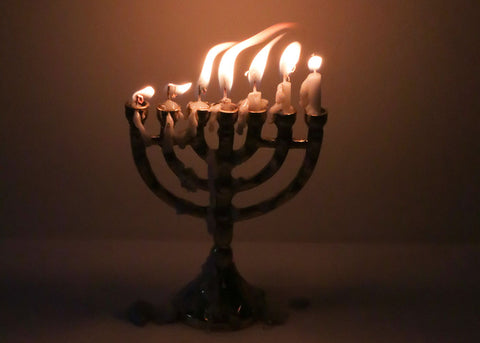The Origins of Christmas
At the House of Pixen we take the origins of Christmas and the traditions of holiday decoration seriously, to say the least. To us, nothing is better than the elegance of a finely detailed home at the holidays. We often draw from deep traditions from around the globe as we craft ornaments and decor. Because of the importance of the history of Christmas decorations and cultural celebrations such as Yule, Solstice and Saturnalia that predated our modern holiday celebrations, we thought we’d take a journey into the known record. Hopefully you will take something away from the article that can enrich your celebration and the traditions you form with your family and friends.
Why do we celebrate Christmas in December?
That’s a question that has been long debated, and many hold that Christmas was set on December 25 in Roman culture to outshine celebrations, chariot races and revelry associated with the birth of the Roman god of the sun, Sol Invictus.

Image by CC BY-SA 3.0 no changes made
Be that as it may, this narrative is incomplete. Where are the pine trees? Where are the garlands and tiny red and white berries? What of the decoration of the tree, collection and distribution of gifts? Where did the candles and star come from? And why have peoples from around the world gravitated to the dead of winter to host a celebration of joy and merrymaking?
The origins of Christmas come from a broad variety of holiday traditions and celebrations from around the world.
We can look to astronomy and astrology for part of the answer. In the northern hemisphere, the shortest day and longest night is called the solstice. Falling on December 21 or 22 of the Gregorian calendar, it corresponds closely with Christmas, and it has been an important marker for many cultures.
The Ancient Egyptians knew how to make powerful stories, and they used a system of symbols and iconography that everyone could easily read. Their religious stories often described natural phenomena, relating them to universal human experience. Ra, the god of the sun, who was depicted with the head of a hawk and a golden crown was believed to become ill due to the onslaught of winter. His illness caused him to traverse the sky in an ever lowering arc. On the Solstice, he began to recover. It was a time for celebration as it marked a shift toward the coming spring and summer to follow.
Palm rushes were collected from trees along the nile and green areas fed by the complex irrigation system built by the Egyptians. These rushes were used in homes as decor to represent “the triumph of life over death.”
 Celebrations around the solstice were not limited to Mediterranean and North African cultures. Druids and Vikings had their own celebrations. The Celtic priests who provided over the Druidic rituals used evergreen boughs to symbolize everlasting life. Like Egyptians, Vikings worshiped a sun god known as Balder. Evergreens were a special plant to Balder as they soaked up the sun and remained green year-round. Several other plants that grew in winter such as holly and ivy became important decorations over time in many parts of Europe.
Celebrations around the solstice were not limited to Mediterranean and North African cultures. Druids and Vikings had their own celebrations. The Celtic priests who provided over the Druidic rituals used evergreen boughs to symbolize everlasting life. Like Egyptians, Vikings worshiped a sun god known as Balder. Evergreens were a special plant to Balder as they soaked up the sun and remained green year-round. Several other plants that grew in winter such as holly and ivy became important decorations over time in many parts of Europe.
Saturnalia was the most significant winter holiday for early Romans. Saturn ruled over agriculture, and thus, a midwinter celebration makes sense to remember and call forth the bounty that summer will bring. At the dawn of the Roman Empire the holiday was but one day, but as late as 31 B.C., celebrations grew, starting on December 17 and lasting a full week.
Wreaths, like those seen in the form of sculpture on the heads of emperors and athletes alike were used to decorate homes along with garlands, and other plant trimmings. Greenery would decorate doorways, stairs, and windows. Decorations also included ornaments in the shapes of the sun and stars. The God Janus was also represented with low relief forms. These decorations would be hung in live trees in communal areas and on personal property.
It was not just the introduction of Christmas that saw the advent of gifting at the holidays. Candles were a common gift as a way to represent the return of light as the days would inevitably grow longer.
 Dressing for the holiday was also important. Colorful clothing replaced the white toga of the ruling classes and decorating oneself with sacred jewelry and vines is represented as common in artwork from the time.
Dressing for the holiday was also important. Colorful clothing replaced the white toga of the ruling classes and decorating oneself with sacred jewelry and vines is represented as common in artwork from the time.
Is the celebration of Christmas a rebranding of pagan holiday traditions?
The Judeo-Christian tradition has its own ancient history. The celebration of Chanukah (Hanukkah) or “celebration of lights” remembers a miraculous event following the rededication of the Second Temple in Jerusalem. The oil lanterns that held only enough oil to burn for a single day burned for eight days straight. Chanukah is celebrated for 8 days in December and participants light candles held in a menorah. Each day a new candle is lit. The traditional menorah holds nine candles instead of eight. The shamash is ninth candle or “helper” and is used to light the other candles. Each day one additional candle is lit until all candles are burning on the 8th day. Celebrations include meals, gift giving and prayers that accompany the lighting of the candles.

A menorah burns brightly, celebrating Chanukah
Many people have speculated that Christmas is merely a rebranding of pagan holiday traditions. In fact, the new testament says nothing about the date of the birth of Jesus leaving later Christians to debate the day on which it should be celebrated. We can see roots for the origins of the Christmas holiday in the Judaic tradition in which Jesus and his early disciples participated. However religious debate about holiday traditions within the late Roman empire was not uncommon.
It is clear that as early as Constantine, paganism was treated as an ancient superstition, not a living religion. One bishop in Turkey is recorded in his own words disapproving of Christian participation in Roman pagan holidays including drinking, dancing, feasting, and even decorating their doorways in greenery.
Pope Gregory in the 16th century suggested an alternative to opposition and religious bans: adopting traditions, reinventing them within Christianity. Boughs, fruits and decorations made from nature were brought in to the churches.
But what of our beloved fir Christmas tree and our modern celebrations replete hand blown glass ornaments, food, company holiday parties, formal dress, beautiful winter wonderland decor, gift giving, and maybe even a kiss under the mistletoe? These features of our contemporary holiday did not emerge in a single moment, but evolved over time.

Glade jul by Viggo Johansen (1891)
The Christmas tree that we know and love came out of the Germanic tradition of decorating a tree with food stuffs, berries and decorations made of greenery, paper and other materials. In the 15th or 16th century these trees celebrating the solstice were adopted by Christians to represent everlasting life. Ornamentation and decoration changed at this time as bulb-shaped ornaments, the angel or star atop the tree began to replace the historical organic, fruit and nut foodstuffs that were commonly used to decorate the tree.
Since that time there has been significant evolution and refinement in our holiday traditions at Christmas time. From the development of hand blown glass ornaments to the tradition of lighting the tree at Rockefeller Plaza, piling gifts under the tree, taking photos with Santa, and our own traditions developed with friends and family, the holiday season remains a beautiful tradition that brings people together. We can see from these varied histories that the origins of Christmas don't come from a single place, but have been developed over time. It's through the celebration of the holiday by decorating, hosting events, collecting and displaying fine, refined ornaments and decor that we pass on these traditions for the generations to come.
Learn more about the history of decorations with our guide.
